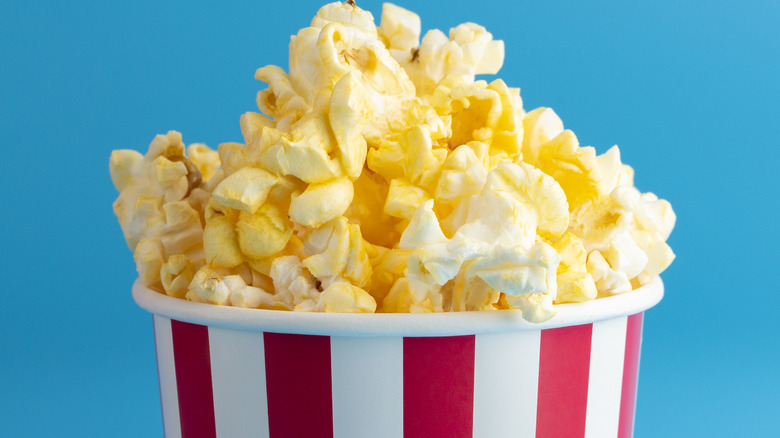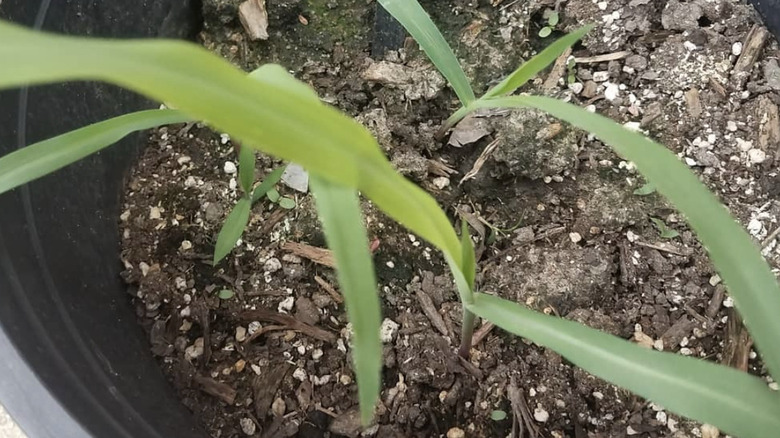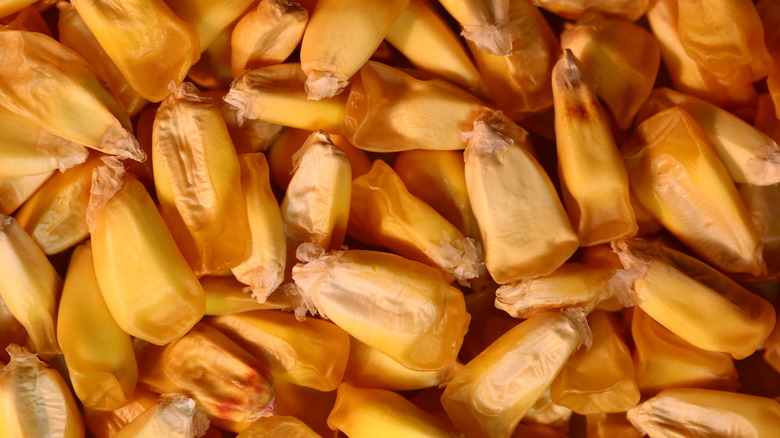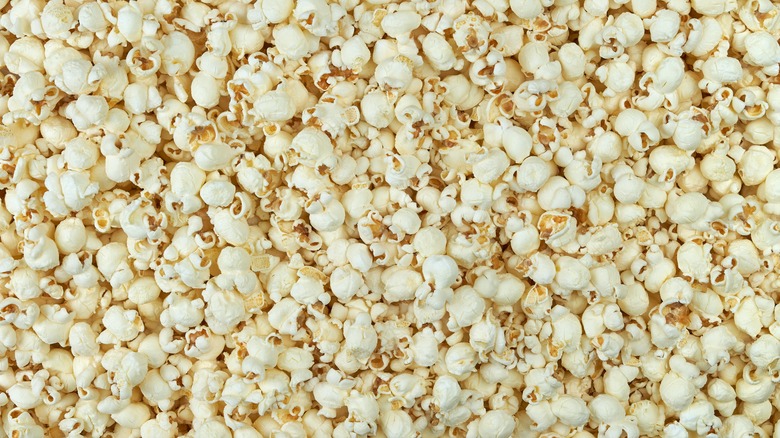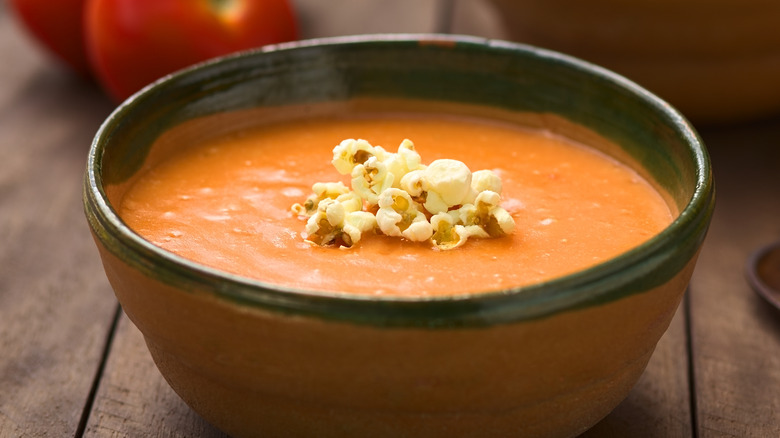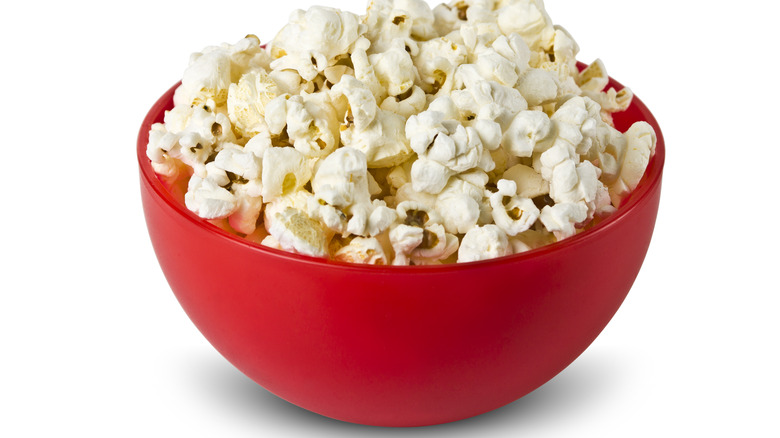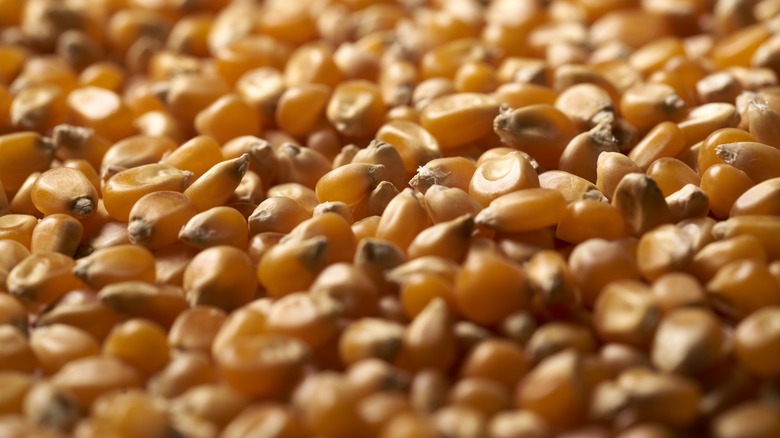The Ancient History Of Popcorn
Almost everybody likes popcorn, because what's not to like? It's a grain, so it tastes a little like bread, but it's also got a nutty taste while remaining light and fluffy and maintaining its flavor even if it's drenched in butter, doused with salt, slathered with caramel, or formed into a sweet and sticky ball. For millions, the idea of watching a movie without a big bowl or bucket of popcorn in their laps is simply unthinkable — popcorn is just that thoroughly entrenched in the modern world as a wholesome, crowd-pleasing movie snack, delivered by the bite or the handful.
Unlike more modern creations like potato chips or chocolate bars, popcorn is the rare carb-laden snack in that it's fully natural, prepared with the simple addition of quick and intense heat to a few hard and durable kernels. It's also healthy, in that it's full of fiber and offers a low caloric density, while also being very, very old. A crop native to North America, popcorn has been enjoyed in its various forms and evolutions, for thousands of years. Here's a look into the big and buttery history of popcorn.
Before it was popcorn, it was teosinte
The one true ancestor of popcorn is teosinte, according to NPR, which isn't a vegetable like corn could be considered, but is actually a grass that grows wild, and in stalks. Each blade-meets-stalk of teosinte produces just a few kernels of very hard corn, far too hard to grind or soften into an edible form with most regular means of cooking. According to Mexico's National Institute of Anthropology and History, teosinte is native to the Southwestern region of that country. The particular variety (via the Washington Post) is the Sea mays ssp. parviglumis subspecies, found in the Central Balsas watershed. That's where, according to National Geographic, this early popcorn was cultivated and mixed with other grains and corn types to become a viable, prolific crop around 9,000 years ago.
In 1948, a Harvard University-sponsored expedition explored an ancient rock enclave in New Mexico called Bat Cave, and discovered remnants of corn dating back about 4,000 years. They were the oldest, most intact, and most important traces of pre-modern corn ever found. These foods don't look like modern popcorn, and they weren't even prepared like modern popcorn. The kernel didn't so much as explode when heated as it did puff out and soften from impossibly hard into pleasantly crunchy. For centuries, popcorn-like grains like this were dried and cooked in a pan in a preparation called parching, until they took on the consistency of something akin to today's CornNuts.
Popcorn popped up in Peru
After growing wild and then being cultivated in what's now Mexico and the American Southwest for thousands of years, with farmers cross-breeding teosinte with cob-based corn, primitive popcorn made its way to South America, according to Serious Eats, via active trade routes. Many indigenous groups grew their own popcorn, and a great many more acquired it. According to iFood.TV, Spanish explorers who encountered indigenous Peruvians in the 1650s wrote about the use of popcorn, indicating that it was toasted over a fire until it exploded and was called pisancalla.
Popcorn was grown and consumed in Peru at least as far back as six millenia. In 2012, archaeologists found the oldest tangible evidence of popcorn ever there, locating 6,700-year-old cobs with puffed and popped kernels still attached (via National Geographic). Previously, only microscopic remains of corn from farther back had existed, while the discovery at the archaeological sites of Huaca Prieta and Paredones gave researchers an idea of just what ancient popcorn looked like, and how it was consumed. Evidence shows that the food was cooked by being wrapped in an indeterminate material and placed on coals, or roasted on the cob over an open flame, or cooked inside earthenware ovens.
Popcorn was vital to the Aztec world
The Aztec Empire was a sophisticated civilization that dominated what is now southern Mexico and Central America for nearly 200 years, generating art, architecture, wealth, and governmental systems from the 1340s until the 1520s. And it was a society built on popcorn. "When you have a very highly productive crop like corn, that makes the rise of high civilizations possible," Smithsonian paleobotanist Dolores Piperno told WGBH. At this time in history, all native, natural corn in the Americas were types of popcorn, emerging from teosinte. Parched and popped corn, or monochitl, became a dietary staple, nutritional source, and cash crop for the Aztecs, whose language even included the word totopoca — defined as the sound of rapidly-popping popcorn kernels.
The food found a place of importance in numerous aspects of Aztec life, according to the Popcorn Board. During ceremonial dances, girls and women would wear crowns made of popped corn, while in other religious ceremonies, garlands of the stuff were used as ornamentation on statues of deities, particularly those representing Tlaloc, the god of rain and fertility.
Spanish conquistador Hernan Cortes and his army first invaded Aztec Mexico in 1519 and would ultimately lay waste to the Aztec capital city of Tenochtitlan in 1521, toppling the empire and claiming the large region it occupied for his European home nation, which emphatically colonized the area. One of the few aspects of Aztec culture not eradicated, but taken back to Europe and spread around the world: popcorn.
The Iroquois made popcorn soup
Popcorn made its way from the Americas to Europe in the 16th century via the Spanish, and their conquest of the Aztec Empire, as well as through other returning explorers and colonizers bringing home botanical treasures of the New World. While Spanish contingents focused on the southern parts of what's now the U.S., French explorers staked claims in the Great Lakes region in the early 1600s, during which time the area was well populated by Iroquois communities.
Popcorn varieties had long since arrived in that area, and according to the U.S. Department of Agriculture, French explorers wrote down their observations of the Iroquois method of preparation. Cooks would place kernels into a clay pot, and then they'd cover it in heated sand. The sand was so hot that it would make the popcorn pop — the exploded pieces were then gathered and used as an ingredient in several dishes, notably a hearty popcorn soup.
Popcorn was a breakfast food in colonial America
Popcorn originated thousands of years ago as a wild grass, spread to western Europe, and then when Europeans began to colonize and build cities in the east coast of what's now the United States, they adopted the native grain as a major and versatile food source. According to the U.S. Department of Agriculture, American colonists widely ate popcorn first thing in the morning — arguably the first entry in the long history of grain-based breakfast cereals in the U.S.
Popped popcorn was served in a bowl, and topped with sugar and cream. It was also eaten later in the day in a savory way, prepared with a fireplace popcorn popper — kernels were placed in a cylinder made of thin iron that turned on an axle to ensure even and proper heat. Popcorn wasn't farmed on a grand scale or available for purchase — subsistence farmers and family farmers would grow and use their own supply.
Why it's popcorn and not popmaize
Popcorn, as we know it today, is a type of corn, known in most of the rest of the world as maize, which comes the Spanish word "maiz," which in turn comes from "mahiz," the name for the food from the Taino community of the Caribbean, according to The Washington Post. In the U.S., it's still called corn, a word derived from Old English that entered the language as "korn," the Old Norse word for grain.
Throughout Europe, "corn" meant the same thing as "grain," and it referred to the dominant cereal or carbohydrate grown in a particular region, according to The Popcorn Board. For example, oats in Scotland were "corn," wheat in England was "corn," and when Europeans colonized North America, they called the native grain source found there "corn" — and the name stuck around. "Popcorn" entered the American vernacular by the 1840s, when it was included in John Russell Bartlett's "Dictionary of Americanisms," according to PBS, with the author pointing out the obvious inspiration, that the word derived from "the noise it makes on bursting open."
